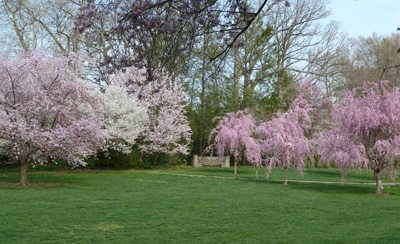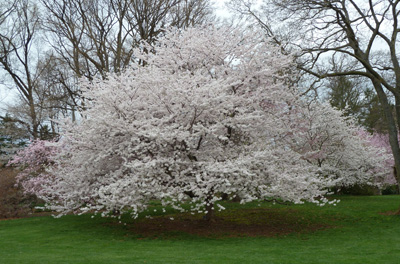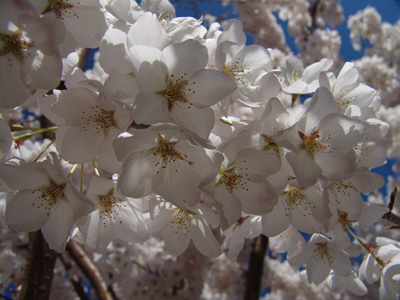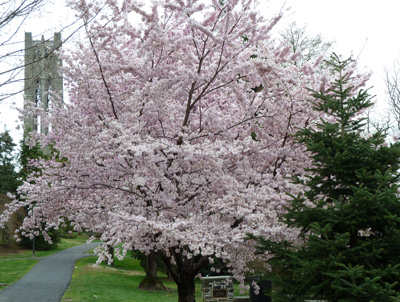Celebrating Cherries

Few can resist! Every April the Cherry Border bursts into bloom, drawing spectators and passersby in with a visual allure that few can defy. Swarthmore students can be found on the lawn reading class texts or enjoying the sunshine. Blossoms invite people off the path for a closer inspection. Children and dogs race through the grass. It is as if the cherries firmly announce the arrival of warm weather.
Many homeowners are faced with a dilemma: the garden can accommodate only one tree. So, which one to choose? The cherry border is an ideal stage to compare the numerous species and cultivars. I find my eye returning time and time again to Prunus x yedoensis, the Yoshino cherry.

Prunus x yedoensis. Photo credit: J. Coceano
The Yoshino cherry was developed in Japan. No one is certain which two plants were crossed, making its parentage and history difficult to trace. Regardless of its muddy past, Yoshino cherries have earned a lasting place in both Japan and the United States. The Arnold Arboretum introduced the cherry to the United States in 1902. This is the species, along with Kwanzan cherry, Prunus ‘Sekiyama’, planted along the Tidal Basin in Washington D.C. Every spring the National Cherry Blossom Festival commemorates the 1912 gift of 3,000 cherries from the mayor of Tokyo, Japan. The trees symbolize and honor the friendship between the two countries. Interestingly, the United States reciprocated the gift in 1915 with a donation of flowering dogwood, Cornus florida.
The tree yields a rounded, spreading habit typically 30’ to 50’ tall. Slightly fragrant flowers occur in racemes of 4 or more blossoms. Select a site with full sun exposure and adequate drainage.

Prunus x yedoensis in flower. Photo credit: Scott Arboretum staff
The cultivar ‘Akebono’ is equally impressive with soft pink double flowers. The glossy, bright green foliage turns subtle shades of orange and yellow in autumn. ‘Akebono’ is slightly smaller and more compact in stature than to P. x yedoensis. Without a doubt, ‘Akebono’ is my favorite cherry!
Curious about other cherry species and cultivars at the Scott Arboretum? The Garden Seeds blog contains an article written by Andrew Bunting, curator, on Late Flowering Cherries. Also online is the Cherry Collection brochure in pdf form. Don’t miss the cherry blossoms!

Prunus x yedoensis 'Akebono' near Wharton Hall. Photo credit: J. Coceano





No Comments